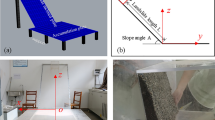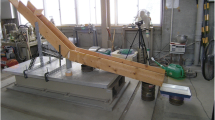Abstract
The mass-front velocities of granular flows results from the joint action of particle size gradations and the underlying surfaces. However, because of the complexity of friction during flow movement, details such as the slope-toe impedance effects and momentum-transfer mechanisms have not been completely explained by theoretical analyses, numerical simulations, or field investigations. To study the mass-front velocity of dry granular flows influenced by the angle of the slope to the runout plane and particle size gradations we conducted model experiments that recorded the motion of rapid and long-runout rockslides or avalanches. Flume tests were conducted using slope angles of 25°, 35°, 45°, and 55° and three particle size gradations. The resulting mass-front motions consisted of three stages: acceleration, velocity maintenance, and deceleration. The existing methods of velocity prediction could not explain the slowing effect of the slope toe or the momentum-transfer steady velocity stage. When the slope angle increased from 25° to 55°, the mass-front velocities dropped significantly to between 44.4% and 59.6% of the peak velocities and energy losses increased from 69.1% to 83.7% of the initial, respectively. The velocity maintenance stages occurred after the slope-toe and mass-front velocity fluctuations. During this stage, travel distances increased as the angles increased, but the average velocity was greatest at 45°. At a slope angle of 45°, as the median particle size increased, energy loss around the slope toe decreased, the efficiency of momentum transfer increased, and the distance of the velocity maintenance stage increased. We presented an improved average velocity formula for granular flow and a geometrical model of the energy along the flow line.
Similar content being viewed by others
References
Baba HO, Peth S (2012) Large scale soil box test to investigate soil deformation and creep movement on slopes by Particle Image Velocimetry (PIV). Soil and Tillage. Research 125: 38–43. DOI: 10.1016/j.still.2012.05.021
Cepeda J, Ch, Ch JA, et al. (2010) Procedure for the selection of runout model parameters from landslide back-analyses: application to the Metropolitan Area of San Salvador, El Salvador.. Landslides 7: 105–116. DOI: 10.1007/s10346-010-0197-9
Chen XZ (1994) Research on the strength of coarse grained soil and the interlocking force. Engineering. Mechanics 11(4): 56–63. (In Chinese)
Chen HR, Kuo KJ, Chen YN, et al. (2011) Model tests for studying the failure mechanism of dry granular soil slopes. Engineering. Geology 119: 51–63. DOI: 10.1016/j.enggeo. 2011.02. 001
Dai ZL, Huang Y, Cheng HL, et al. (2014) 3D numerical modeling using smoothed particle hydrodynamics of flow-like landslide propagation triggered by the 2008 Wenchuan earthquake. Engineering Geology 180: 21–33. DOI: 10.1016/j. enggeo.2014.03.018
Davies TR, Mcsaveney MJ, Hodgson KA (1999) A fragmentation-spreading model for long-runout rock avalanches. Canadian Geotechnical Journal. 36: 1096–1110.
Davies TRH (1982) Spreading of rock avalanche debris by mechanical fluidization. Rock. Mech. 15(1): 9–24. DOI: 10.1016/0148-9062(82)91422-X
Deline P (2009) Interactions between rock avalanches and glaciers in the Mont Blanc massif during the late Holocene. Quaternary Science. Reviews 28: 1070–1083. DOI: 101016/j. quascirev. 2008.09.025
Devoli G, Blasio FVD, ElverhEl A, et al. (2009) Statistical Analysis of Landslide Events in Central America and their Run-out Distance. Geotechnical and Geological. Engineering 27: 23–42. DOI: 10.1007/s10706-008-9209-0
Eisbacher GH (1979) Cliff collapse and rock avalanches (sturstroms) in the Machenzie Mountains, northwestern Canada. Canadian Geotechnical. Journal 16: 309–334.
Evans SG, Hungr O, Clague JJ (2001) Dynamics of the 1984 rock avalanche and associated distal debris flow on Mount Cayley, British Columbia, Canada; implications for landslide hazard assessment on dissected volcanoes. Engineering. Geology 61(1): 29–51.
Fahnestock RK (1978) Little Tahoma peak rockfalls and avalanches, Mount Rainier, Washington, USA. In: Voight B (Ed.), Rockslides and Avalanches. 1. Natural Phenomena. Elsevier, Amsterdam. pp 181–196.
Feng WK, He C, Shi YC, et al. (2009) Simulation analysis of formation mechanism of some complex and giant landslides using three-dimensional discrete elements, Rock and Soil. Mechanics 30(4): 1122–1126. (In Chinese)
Gray JMNT, Tai YC, Noelle S (2003) Shock waves, dead zones and particle-free regions in rapid granular free-surface flows. Journal of Fluid. Mechanics 491: 161–181. DOI: 10.1017/ S0022112003005317
Gray JMNT (2013) A hierarchy of particle-size segregation models: From polydisperse mixtures to depth-averaged theories. AIP Conference Proceedings 1542: 66–73. DOI: 10.1063/ 1.4811869
Gray JMNT, Gajjara P, Kokelaar P (2015) Particle-size segregation in dense granular avalanches. Comptes Rendus. Physique 16: 73–85. DOI: 10.1016/j.crhy.2015.01.004
Holsapple KA (2013) Modeling granular material flows: The angle of repose, fluidization and the cliff collapse problem. Planetary and Space Science 82-83: 11–26. DOI: 10.1016/ j.pss. 2013.03.001
Huang RQ, Xu Q (2008) Catastrophic landslides in China. Science Press, Beijing, China. pp 125–129. (In Chinese)
Hungr O (1995) A model for the runout analysis of rapid flow slides, debris flows, and avalanches. Canadian Geotechnical Journal 32: 610–623.
Hungr O (2006) Rock avalanche occurrence, process and modelling. Earth and Environ-mental. Science 49(4): 243–266.
Hungr O, McDougall S (2009) Two numerical models for landslide dynamic analysis. Computers &. Geosciences, 35: 978–992. DOI: 10.1016/j.cageo.2007.12.003
Kent PE (1966) The transport mechanism in catastrophic rock falls.. Geology 74: 79–83.
Kokelaara BP, Grahama RL, Gray JMNT, et al. (2014) Finegrained linings of leveed channels facilitate runout of granular flows. Earth and Planetary Science. Letters 385: 172–180. DOI: 10.1016/j.epsl.2013.10.043
Kwan JSH, Sun HW (2006) An improved landslide mobility model. Canadian Geotechnical. Journal 43(5): 531–539. DOI: 10.1139/T06-010
Li WC, Li HJ, Dai FC, et al. (2012) Discrete element modeling of a rainfall-induced flowslide Engineering Geology 149-150: 22–34. DOI: 10.1016/j.enggeo.2012.08.006
Linares-Guerrero E, Goujon C, Zenit R (2007) Increased mobility of bidisperse granular flows. Journal of Fluid. Mechanics 593: 475–504. DOI: 10.1017/S0022112007008932
Liu ZN, Koyi HA, Swantesson JOH, et al. (2013) Kinematics and 3-D internal deformation of granular slopes: Analogue models and natural landslides. Journal of Structural. Geology 53: 27–42. DOI:10.1016/j.jsg.2013.05.010
Lo CM, Lin ML, Tang CL, et al. (2011) A kinematic model of the Hsiaolin landslide calibrated to the morphology of the landslide deposit. Engineering Geology 123: 22–39. DOI: 10.1016/j.enggeo.2011.07.002
Manzella I, Labiouse V (2009) Flow experiments with gravel and blocks at small scale to investigate parameters and mechanisms involved in rock avalanches. Engineering. Geology 109: 146–158. DOI: 10.1016/j.enggeo.2008.11.006
Marks B, Rognon P, Einav I (2012) Grainsize dynamics of polydisperse granular segregation down inclined planes. Journal of Fluid. Mechanics. 690: 499–511. DOI: 10.1017/ jfm.2011. 454
Marks B, Valaulta A, Puzrin A, et al. (2013) Design of protection structures: the role of the grain size distribution. AIP Conference. Proceedings, 1542: 658–661. DOI: 10.1063/ 1.4812017
Moro F, Faug T, Bellot H, et al. (2010) Large mobility of dry snow avalanches: Insights from small-scale laboratory tests on granular avalanches of bidisperse materials. Cold Regions Science and. Technology 62: 55–66. DOI: 10.1016/j. coldregions.2010.02.011
Okada Y, Ochiai H (2008) Flow characteristics of 2-phase granular mass flows from model flume tests. Engineering. Geology 97: 1–14. DOI: 10.1016/j.enggeo.2007.10.004
Okura Y, Kitahara H, Sammori T (2000) Fluidization in dry landslides. Engineering. Geology 56: 347–360.
Phillips JC, Hogg AJ, Kerswell RR, et al. (2006) Enhanced mobility of granular mixtures of fine and coarse particles. Earth and Planetary Science Letters 246(3-4): 466–480. DOI: 10.1016/j.epsl.2006.04.007
Pirulli M (2010) Morphology and Substrate Control on the Dynamics of Flowlike Landslides. Journal of Geotechnical and Geoenvironmental. Engineering 136(2): 376–388. DOI: 10.1061/(ASCE)GT.1943-5606.0000221
Pudasaini SP, Miller SA (2013) The hypermobility of huge landslides and avalanches. Engineering. Geology 157: 124–132. DOI: 10.1016/j.enggeo.2013.01.012
Revellino P, Guadagno FM, Hungr O (2008) Morphological methods and dynamic modeling in landslide hazard assessment of the Campania Apennine carbonate slope.. Landslides 5: 59–70. DOI: 10.1007/s10346-007-0103-2
Sassa K (1988) Geotechnical model for the motion of landslides (Special lecture). Landslides, C. Bonnard, Editor, Proceedings, 5th International Symposium on. Landslides 1: 37–56.
Sassa J, Nagai O, Solidum R, et al. (2010) An integrated model simulating the initiation and motion of earthquake and rain induced rapid landslides and its application to the 2006 Leyte landslide.. Landslides 7: 219–236. DOI: 10.1007/s10346-010-0230-z
Savage SB, Hunter K (1989) The motion of a finite mass of granular material down a rough incline. Journal of Fluid. Mechanics 199: 177–215.
Scheidegger AE (1973) On the prediction of the reach and velocity of catastrophic landslides. Rock Mechanics and Rock. Engineering 5: 231–236.
Shi GH, Goodman RE (1989) Generalization of two-dimensional discontinuous deformation analysis for forward modeling. International Journal for Numerical and Analytical Methods in. Geomechanics 13(3): 59–80. DOI: 10.1002/nag. 1610130403
Shreve RL (1968a) The Blackhawk landslide. Geological Society of America. Special 108: 47.
Shreve RL (1968b) Leakage and fluidization in air-layer lubricated avalanches. Geological Society of America. Bulletin 79: 653–658.
Sosio R, Crosta GB, Chen JH, et al. (2012) Modelling rock avalanche propagation onto glaciers. Quaternary Science. Reviews 47: 23–40. DOI: 10.1016/j.quascirev.2012.05.010
Straub S (1997) Predictability of long runout landslide motion: implications from granular flow mechanics. Geologische. Rundschau. 86: 415–425. DOI: 10.1007/s005310050150
Tai YC, Kuo CY (2008) A new model of granular flows over general topography with erosion and deposition. Acta Mechanica 199: 71–96. DOI: 10.1007/s00707-007-0560-7
Tai YC, Lin YC (2008) A focused view of the behavior of granular flows down a confined inclined chute into the horizontal run-out zone. Physics of Fluids 20(12): 1–11. DOI: 10.1063/1.3033490
Willenberg H, Eberhardt E, Loew S, et al. (2009) Hazard assessment and runout analysis for an unstable rock slope above an industrial site in the Riviera valley. Switzerland.. Landslides 6: 111–116. DOI: 10.1007/s10346-009-0146-7
Wu AQ, Ding XL, Li HZ, et al. (2006) Numerical simulation of startup and whole failure process of qianjiangping landslide using discontinuous deformation analysis method. Chinese Journal of Rock Mechanics and. Engineering 25 (7): 1297–1303.(In Chinese)
Xing AG, Ying YP (2009) Whole Course Analysis on Hydrokineties Mechanism of Touzhai Gully Landslide. Journal of Tongji University (Natural. Science) 37(4): 481–485. (In Chinese)
Yang CM, Yu WL, Dong JJ, et al. (2014) Initiation, movement, and run-out of the giant Tsaoling Landslide-What can we learn from a simple rigid block model and a velocitydisplacement dependent friction law? Engineering. Geology 182: 158–181. DOI: 10.1016/j.enggeo.2014.08. 008
Yang QQ, Cai F, Ugai K, et al. (2011) Some factors affecting mass-front velocity of rapid dry granular flows in a large flume. Engineering. Geology 122: 249–260. DOI: 10.1016/j. enggeo. 2011.06.006
Yoichi O, Hikaru K, Toshiaki S, et al. (2000) The effects of rockfall volume on runout distance. Engineering. Geology 58: 109–124.
Zaniboni F, Tinti S (2014) Numerical simulations of the 1963 Vajont landslide, Italy: application of 1D Lagrangian modeling. Natural. Hazards 70: 567–592. DOI: 10.1007/s11069-013-0828-2
Zhang M, Hu RL, Yin YP, et al. (2010) Study of transform mechanism of landslide-debris flow with ring shear test. Chinese Journal of Rock Mechanics and. Engineering 29(4): 822–832. (In Chinese)
Zhang YB, Wang JM, Xu Q, et al. (2015) DDA validation of the mobility of earthquake-induced landslides. Engineering Geology 194: 38–51. DOI: 10.1016/j.enggeo.2014.08.024
Author information
Authors and Affiliations
Corresponding author
Additional information
http://orcid.org/0000-0001-9001-1819
https://orcid.org/0000-0003-2058-6419
https://orcid.org/0000-0003-4683-4898
Rights and permissions
About this article
Cite this article
Fan, Xy., Tian, Sj. & Zhang, Yy. Mass-front velocity of dry granular flows influenced by the angle of the slope to the runout plane and particle size gradation. J. Mt. Sci. 13, 234–245 (2016). https://doi.org/10.1007/s11629-014-3396-3
Received:
Accepted:
Published:
Issue Date:
DOI: https://doi.org/10.1007/s11629-014-3396-3




